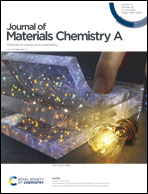Gradient porosity electrodes for fast charging lithium-ion batteries†
Abstract
The tendency of Li plating at the surface of thick graphite electrodes greatly limits their application in electrical vehicle (EV) batteries for fast charging applications. To address this concern, we proposed an innovative gradient porosity architecture to facilitate mass transport and suppress Li plating in the thick anodes for fast charging applications. This concept was approved through a thick 3-layered graphite electrode with the highest porosity in the top layer and the lowest porosity in the bottom layer, in contact with the current collector. The gradient porosity structure in the 3-layered graphite electrodes was confirmed by electron microscopy and mercury porosimetry measurements. Used as the anodes of lithium-ion batteries, 3-layered graphite electrodes demonstrated unprecedentedly rate capability and durability superior to 1-layered electrodes. The post-mortem analysis on the cycled cells shows that 3-layered electrodes can significantly suppress Li plating at a high rate up to 4C, which might be responsible for the improved performance of the derived cells. The excellent electrochemical behaviors of 3-layered graphite electrodes are associated with the favored mass transport originating from the unique gradient porosity structure. This is consistent with theoretical studies showing that gradient porosity lowers the Li-ion concentration gradient in the electrolyte in the region close to the separator and slows down the process of reaching the Li plating threshold.



 Please wait while we load your content...
Please wait while we load your content...